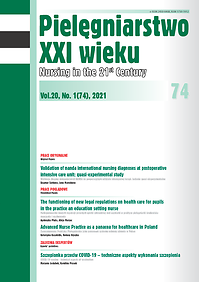Validation of NANDA International nursing diagnoses at postoperative intensive care unit: quasi-experimental study
DOI:
https://doi.org/10.2478/pielxxiw-2021-0006Keywords:
NANDA International, DCV model, validation, intensive care, adultAbstract
VALIDATION OF NANDA INTERNATIONAL NURSING DIAGNOSES AT POSTOPERATIVE INTENSIVE CARE UNIT: QUASI-EXPERIMENTAL STUDY
Aim. Implement repeated validation of three NANDA International nursing diagnoses before and after their experimental classification in daily nursing practice at an intensive care unit for adults, at a medium-sized hospital. Identify statistically significant differences in Diagnostic Content Validation (DCV) values between the two validations.
Material and methods. Fehring's DCV model was used for validation of NANDA International diagnoses. The sample of assessors consisted of 33 experts in the first stage and of 31 experts in the second stage, the experts were in both cases ICU nurses. Nursing diagnoses were experimentally applied in practice for 3 months. The data were processed using descriptive statistics, Wilcoxon matched pairs test and paired t-test.
Results. Total DCV scores of diagnoses after the first validation: Impaired gas exchange 00030 with DCV 0.67; Risk for disuse syndrome 00040 with DCV 0.69 and Risk for aspiration 00039 with DCV 0.73. The DCV values after the second validation were as follows: 0.63; 0.64 and 0.78 respectively.
Conclusions. Nursing diagnoses: Impaired gas exchange 00030, Risk for disuse syndrome 00040 and Risk for aspiration 00039 are valid for nursing diagnostics of adult lucid postoperative intensive care unit patients at a medium-sized hospital.
References
1. Kavalieratos D, Corbelli J, Zhang K, et al. Association between palliative care and patient and caregivers outcomes. A systematic review and meta-analysis. JAMA. 2016; 316(20): 2104-2114.
2. Turner-Stokes L, McCrone P, Jackson D, Siegert R. The Needs and Provision Complexity Scale: measuring met and unmet needs in the community for patients with complex neurological disabilities. Neurorehabilitation and Neural Repair. 2013; 3(2): 695-704.
3. Hussain J, Adams D, Campbell C. End-of-life care in neurodegenerative conditions: outcomes of a specialist palliative neurology service. International Journal of Palliative Nursing. 2013; 19(4), 162-169.
4. Lageman S, Cash T, Mickens M. Patient-reported needs, non-motor symptoms and quality of life in essential tremor and Parkinson’s Disease. Tremor and Other Hyperkinetic Movements. 2014; 4(240): doi: 10.7916/D8RF5S4J.
5. Mansfield E, Boyes AW, Sanson-Fisher R. Quantifying the unmet needs of caregivers of people with dementia: A critical review of the quality of measures. International Journal of Geriatric Psychiatry. 2017; 32(3): 274-287.
6. Van der Eijk M, Faber M, Shamma S, Munneke M, et al. Moving towards patient-centered healthcare for patients with Parkinson’s disease. Parkinsonism & Related Disorders. 2011; 17(5): 360-364.
7. Asadi Lari M, Tamburini M, Gray D. Patients’ needs, satisfaction, and health related quality of life: towards a comprehensive model. Health Quality of Life Outcomes. 2004; 2(32): 1-15.
8. Calvert M, Pall H, Hoppitt T, et al. Health-related quality of life and supportive care in patients with rare long-term neurological conditions. Quality Life Research. 2013; 22(6): 1231-1238.
9. McColl MA, Jarzynowska A, Shortt S. Unmet health care needs of people with disabilities: population level evidence. Disability & Society. 2010; 25(2): 205-218.
10. Anderson F, Downing GM, Hill J, et al. Palliative performance scale (PPS): a new tool. Journal of Palliative Care. 1996; 12(1): 5-11.
11. Mahoney FI, Barthel D. Functional evaluation: the Barthel index. Maryland State Medical Journal. 1965; 14: 56-61.
12. Waller A, Girgis A, Lecathelinas Ch, et al. Palliative care research program, validity, reliability and clinical feasibility of a Needs Assessment Tool for people with progressive cancer. Psychooncology. 2010; 19(7): 726-733.
13. Hansen D, Larsen P, Holm L, et al. Association between unmet needs and quality of life of cancer patients: A population-based study. Acta Oncologica. 2013; 52(2): 391-399.
14. Siegert R, Jackson D, Turner-Stokes L. The Needs and Provision Complexity Scale: a first psychometric analysis using multicentre data. Clinical Rehabilitation. 2014; 8(7): 687-695.
15. Buetow S, Giddings L, Williams L, et al. Perceived unmet needs for health care among Parkinson’s Society of New Zealand members with Parkinson’s disease. Parkinsonism & Related Disorders. 2008; 14(6): 495-500.
16. Lee J, Kim Y, Kim S, et al. Unmet needs of people with Parkinson’s disease: A cross‐sectional study. Journal of Advanced Nursing. 2019; 75(12): 3504-3514.
17. Van Walsem M, Howe E, Ruud G, et al. Health-related Quality of Life and Unmet Healthcare Needs in Huntington’s Disease. Health and Quality of Life Outcomes. 2017; 7(15): 1-6.
18. Holmoy A, Johannssen C, Hope S, et al. Uncovering health and social care needs among myotonic dystrophy patients. Acta Neurologica Scandinavica, 2019; 139(6): 526-532.
Downloads
Published
Issue
Section
License
Copyright (c) 2021 Authors

This work is licensed under a Creative Commons Attribution-NonCommercial-NoDerivatives 4.0 International License.




